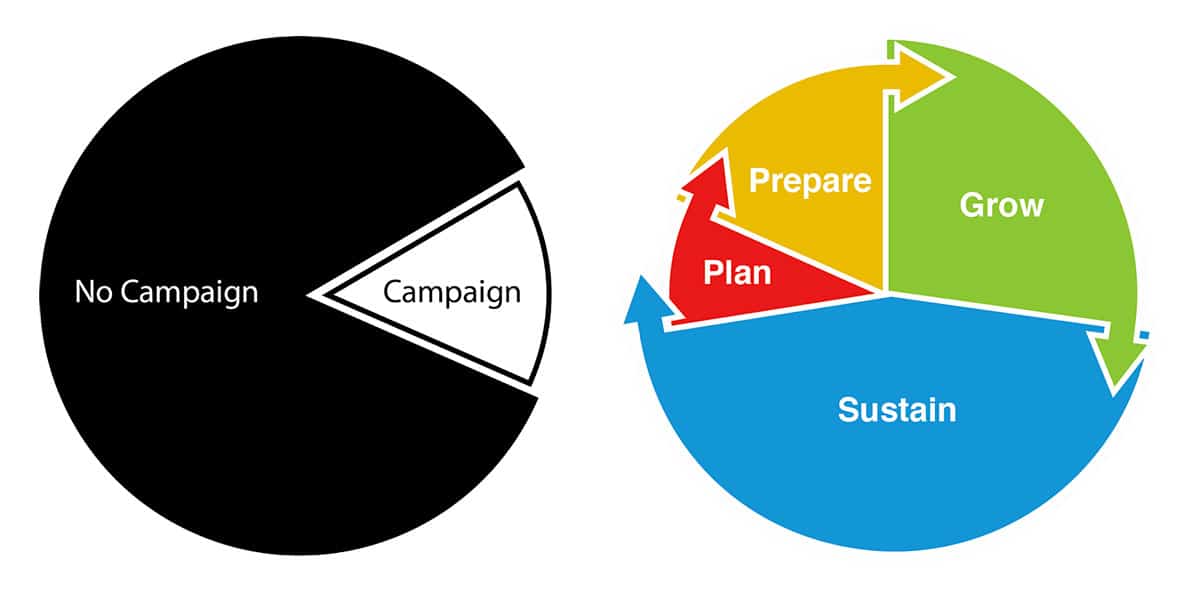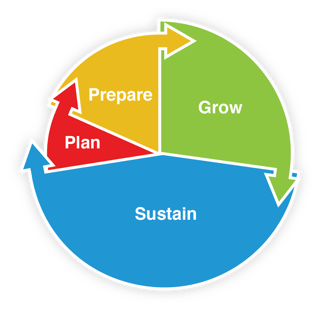There are two different types of nonprofit agencies: those on the Campaign Cycle and those on the Growth Cycle.
Organizations on the Campaign Cycle (CC) are either in a capital campaign or they are not—there is no in-between. When they are not in a campaign, they simply go along with their daily business. They are not planning for future growth or even sustainability. Then one day the agency is surprised to find out they are swamped with need, so they launch a campaign to meet that need. I want to ask, “Didn’t you see this coming?”
CC organizations are not prepared for the campaign when it comes. Furthermore, too often they are unprepared to sustain their organization’s growth after the campaign. CC organizations miss strategic opportunities because they are looking at their feet instead of the horizon. They have this nagging feeling that they are always playing catch-up. The truth is that CC organizations are always in crisis mode because they are inattentive and reactive instead of engaged and proactive.
The Campaign Cycle looks like this:
There is a better way. Other agencies operate in the much more intentional Growth Cycle (GC). They recognize that at some point the agency is going to grow, even if it will not be for years. Thus, GC agencies are always thinking a few steps ahead. If they are currently planning for a campaign, they are also thinking about how they will achieve sustainability after the campaign. If they are in a sustainability stage, they recognize that growth will once again be in their future and begin positioning the agency accordingly.
Here are the stages of the Growth Cycle and how to make the most of each stage:
Plan
Prepare
Like a farmer getting the tractors ready and preparing the soil for spring planting, GC organizations prepare their systems for growth. This may involve developing their leadership team, building their fundraising base, or conducting a community needs assessment. This stage is all about building up the strength to maintain current operations while putting in the extra effort to grow to a higher level in the future.
Grow
Once GC organizations are well-prepared, it is time to implement the plan. This is where all hands need to be on deck to help push the organization through the growth stage, a period of intense effort and coordination to propel the organization forward. Often times, major growth is accomplished through a capital campaign. Other times, the growth is accomplished through very intensive strategic initiatives. Either way…
Sustain
The work is not over when the building is erected or the new program is in place. Having achieved their growth goals, GC organizations must sustain them. The sustain stage has a two-pronged focus: first, maintaining the new level of impact/quality, and second, looking ahead to the next big growth spurt.
Here are a few ideas for how to more effectively sustain:
- Every three years, engage in strategic planning.
- Recruit board members who can help build the maturity of your agency.
- Develop your fundraising program to acquire more donors, retain the donors you have, and lift average giving.
- Build your network in your community.
So, is your nonprofit in the Campaign Cycle or the Growth Cycle? Knowing how your agency operates is the first step to gaining control over the future.
Brent works with nonprofit agencies at any stage of the Growth Cycle, as well as agencies that need help leaving the Campaign Cycle behind. Services include capital campaign readiness and counsel, leadership development, and strategic planning. Contact us today to schedule a free Growth Cycle check-up.




